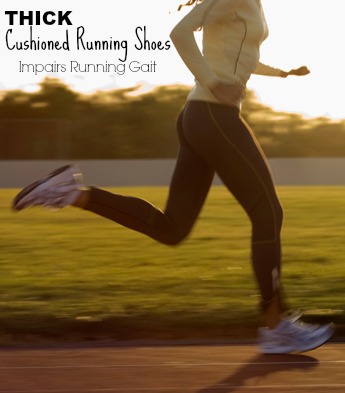With all the running shoes to choose from, they all have one thing in common = too much cushioning. You’ve probably ran in them, I did at one time, and you’ve probably got injured, too. Here are a few things about your cushioned running shoes that you should keep in mind.
Thick cushioned running shoes impair your proper, natural running gait (forefoot running gait) by producing sizable alterations in foot strike mechanics during the swing phase of running.
Thick Cushioned Running Shoes Impair Running Gait
Running shoes with heel cushioning facilitates a heel strike landing which produces an impact transient that converts into a shock-wave that, over time, causes degenerative joint problems in addition to musculoskeletal injuries [1,2]. How do we know this? The proof is in the pudding.
A study by Lieberman et al. [2] compared the foot strikes of barefoot and endurance runners wearing thick heel running shoes and found the following:
- runners in thick heeled running shoes over-strided and landed hard on their heels
- thick heeled running shoes caused the center mass to pass through a greater horizontal displacement with each step during running
- heel striking in thick heeled running shoes generated higher peak loading, peak vertical impact, and peak braking
The multiple forces produced in a running shoe-induced heel strike landing are linked to common running injuries such as runners knee and shin fractures.
Even worse, thick heeled running shoes are very inflexible, giving rise to the idea that such footwear causes foot weakness by limiting plantar reflexes and muscle activation. This is how the muscles, tendons, and bones of the foot become susceptible to atrophy.
Minimalist Footwear Improves Foot Strike and Strength
Ample studies found that minimalist footwear tremendously improves foot strength and in most cases, promotes a forefoot strike over a heel strike landing during running.
Many joggers underestimate proper running shoes, unaware that too much shoe cushioning encourages a foot strike that is all too forceful.
But, is there a right or wrong way to run?
According to Lieberman et al., before modern running shoes, humans not only ran barefoot for millions of years and later on in very, minimalist type footwear such as moccasins or thin sandals; it would make sense that to run safely barefoot, early runners adopted a forefoot strike because impact landing forces are much smaller regardless of surface hardness.
Try landing on your heels while running barefoot, it hurts, which is why most barefoot runners land on the front part of their foot.
This means that humans today have retained the same forefoot strike pattern our ancestors adopted millions of years ago, which is the answer to the million dollar question: forefoot running is the right way to run.
More on How Heel Striking Causes Injury:
References:
[1]. Collins, JJ and Whittle, MW. Impulsive forces during walking and their clinical implications. Clin Biomech, 1989; 4:179-187.
[2]. Lieberman et al. Foot strike patterns and collision forces in habitually barefoot versus shod runners. Nature (2010); 463: 531-535.
Bretta Riches
BSc Neurobiology; MSc Biomechanics candidate, ultra minimalist runner & founder of RunForefoot. I was a heel striker, always injured. I was inspired by the great Tirunesh Dibaba to try forefoot running. Now, I'm injury free. This is why I launched Run Forefoot, to advocate the health & performance benefits of forefoot running and to raise awareness on the dangers of heel striking, because the world needs to know.
Latest posts by Bretta Riches (see all)
- Can You Run In Barefoot Shoes? Yes, But DON’T Heel Strike! - 21/07/2024
- Why Cushioned Running Shoes Are Really Bad for Your Feet - 19/07/2024
- Do Cushioned Running Shoes Cause Injuries? - 17/07/2024



Leave a Reply